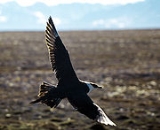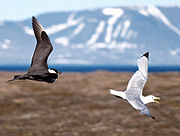
Arctic Skua
Encyclopedia
The Parasitic Jaeger, also known as the Arctic Skua or Parasitic Skua, (Stercorarius parasiticus) is a seabird
in the skua
family Stercorariidae.
This species breeds in the north of Eurasia
and North America, with significant populations as far south as northern Scotland
. It nests on dry tundra
, higher fells and islands, laying up to four olive-brown eggs. It is usually silent except for newing and wailing notes while on the breeding grounds. Like other skuas, it will fly at the head of a human or fox approaching its nest. Although it cannot inflict serious damage, it is a frightening and painful experience. It is a migrant
, wintering at sea in the tropics and southern oceans.
In the British Isles
, they breed in Shetland and Orkney, the Outer Hebrides
, Sutherland
, Caithness
, and some islands in Argyll
.
This bird will feed on rodents, small birds and insects but also robs gull
s and tern
s of their catches. Like the larger skua species
, it continues this piratical behaviour throughout the year, showing great agility as it harasses its victims.
 Identification of this skua is complicated by its similarities to Long-tailed Skua
Identification of this skua is complicated by its similarities to Long-tailed Skua
and Pomarine Skua
, and the existence of three colour phases. This is a smallish skua. It measures 41–48 cm (16.1–18.9 in) in length, 107–125 cm (42.1–49.2 in) in wingspan and weighs 300–650 g (0.661386786554633–1.4 lb). The tail streamer of the breeding adult accounts for about 7 cm (2.8 in) of their length. Light phase adults have a brown back, mainly white underparts and dark primary wing feathers with a white "flash". The head and neck are yellowish-white with a black cap and there is a pointed central tail projection. Dark phase adults are dark brown, and intermediate phase birds are dark with somewhat paler underparts, head and neck. All phases have the white wing flash.
Juveniles are even more problematic, and are difficult to separate from Long-tailed Skua over the sea. They are bulkier, shorter-winged and less tern-like than that species, but show the same wide range of plumage variation. The flight is more falcon
-like. However, they are usually warmer toned than Long-tailed, with browner shades, rather than grey.

Seabird
Seabirds are birds that have adapted to life within the marine environment. While seabirds vary greatly in lifestyle, behaviour and physiology, they often exhibit striking convergent evolution, as the same environmental problems and feeding niches have resulted in similar adaptations...
in the skua
Skua
The skuas are a group of seabirds with about seven species forming the family Stercorariidae and the genus Stercorarius. The three smaller skuas are called jaegers in North America....
family Stercorariidae.
This species breeds in the north of Eurasia
Eurasia
Eurasia is a continent or supercontinent comprising the traditional continents of Europe and Asia ; covering about 52,990,000 km2 or about 10.6% of the Earth's surface located primarily in the eastern and northern hemispheres...
and North America, with significant populations as far south as northern Scotland
Scotland
Scotland is a country that is part of the United Kingdom. Occupying the northern third of the island of Great Britain, it shares a border with England to the south and is bounded by the North Sea to the east, the Atlantic Ocean to the north and west, and the North Channel and Irish Sea to the...
. It nests on dry tundra
Tundra
In physical geography, tundra is a biome where the tree growth is hindered by low temperatures and short growing seasons. The term tundra comes through Russian тундра from the Kildin Sami word tūndâr "uplands," "treeless mountain tract." There are three types of tundra: Arctic tundra, alpine...
, higher fells and islands, laying up to four olive-brown eggs. It is usually silent except for newing and wailing notes while on the breeding grounds. Like other skuas, it will fly at the head of a human or fox approaching its nest. Although it cannot inflict serious damage, it is a frightening and painful experience. It is a migrant
Bird migration
Bird migration is the regular seasonal journey undertaken by many species of birds. Bird movements include those made in response to changes in food availability, habitat or weather. Sometimes, journeys are not termed "true migration" because they are irregular or in only one direction...
, wintering at sea in the tropics and southern oceans.
In the British Isles
British Isles
The British Isles are a group of islands off the northwest coast of continental Europe that include the islands of Great Britain and Ireland and over six thousand smaller isles. There are two sovereign states located on the islands: the United Kingdom of Great Britain and Northern Ireland and...
, they breed in Shetland and Orkney, the Outer Hebrides
Outer Hebrides
The Outer Hebrides also known as the Western Isles and the Long Island, is an island chain off the west coast of Scotland. The islands are geographically contiguous with Comhairle nan Eilean Siar, one of the 32 unitary council areas of Scotland...
, Sutherland
Sutherland
Sutherland is a registration county, lieutenancy area and historic administrative county of Scotland. It is now within the Highland local government area. In Gaelic the area is referred to according to its traditional areas: Dùthaich 'IcAoidh , Asainte , and Cataibh...
, Caithness
Caithness
Caithness is a registration county, lieutenancy area and historic local government area of Scotland. The name was used also for the earldom of Caithness and the Caithness constituency of the Parliament of the United Kingdom . Boundaries are not identical in all contexts, but the Caithness area is...
, and some islands in Argyll
Argyll and Bute
Argyll and Bute is both one of 32 unitary council areas; and a Lieutenancy area in Scotland. The administrative centre for the council area is located in Lochgilphead.Argyll and Bute covers the second largest administrative area of any Scottish council...
.
This bird will feed on rodents, small birds and insects but also robs gull
Gull
Gulls are birds in the family Laridae. They are most closely related to the terns and only distantly related to auks, skimmers, and more distantly to the waders...
s and tern
Tern
Terns are seabirds in the family Sternidae, previously considered a subfamily of the gull family Laridae . They form a lineage with the gulls and skimmers which in turn is related to skuas and auks...
s of their catches. Like the larger skua species
Species
In biology, a species is one of the basic units of biological classification and a taxonomic rank. A species is often defined as a group of organisms capable of interbreeding and producing fertile offspring. While in many cases this definition is adequate, more precise or differing measures are...
, it continues this piratical behaviour throughout the year, showing great agility as it harasses its victims.

Long-tailed Skua
The Long-tailed Skua, Stercorarius longicaudus is a seabird in the skua family Stercorariidae....
and Pomarine Skua
Pomarine Skua
The Pomarine Skua, Stercorarius pomarinus, known as Pomarine Jaeger in North America, is a seabird in the skua family Stercorariidae. It is a migrant, wintering at sea in the tropical oceans.- Taxonomy :...
, and the existence of three colour phases. This is a smallish skua. It measures 41–48 cm (16.1–18.9 in) in length, 107–125 cm (42.1–49.2 in) in wingspan and weighs 300–650 g (0.661386786554633–1.4 lb). The tail streamer of the breeding adult accounts for about 7 cm (2.8 in) of their length. Light phase adults have a brown back, mainly white underparts and dark primary wing feathers with a white "flash". The head and neck are yellowish-white with a black cap and there is a pointed central tail projection. Dark phase adults are dark brown, and intermediate phase birds are dark with somewhat paler underparts, head and neck. All phases have the white wing flash.
Juveniles are even more problematic, and are difficult to separate from Long-tailed Skua over the sea. They are bulkier, shorter-winged and less tern-like than that species, but show the same wide range of plumage variation. The flight is more falcon
Falcon
A falcon is any species of raptor in the genus Falco. The genus contains 37 species, widely distributed throughout Europe, Asia, and North America....
-like. However, they are usually warmer toned than Long-tailed, with browner shades, rather than grey.

External links
- More Arctic skua information and photos at the Handa Island Skua Project
- RSPB A to Z of UK Birds

